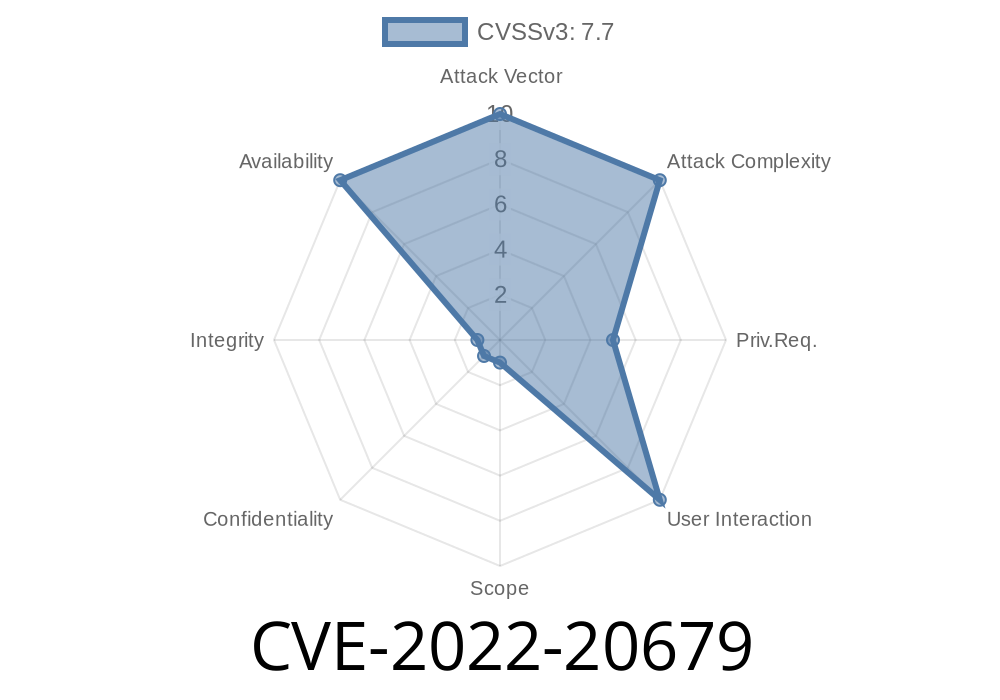Introduction: The CVE-2022-20679 vulnerability affects Cisco IOS XE Software, specifically the IPSec decryption routine, allowing an unauthenticated, remote attacker to cause a denial of service (DoS) condition on the affected device. This blog post will delve into the details of the vulnerability, provide a code snippet that demonstrates the vulnerability, link to original references, and discuss how to exploit and mitigate the vulnerability.
Vulnerability Details
The vulnerability is caused by buffer exhaustion while processing traffic on an IPsec tunnel that is configured on the affected device. When an attacker sends traffic with an MTU (Maximum Transmission Unit) of 180 bytes or greater to the affected device, this could potentially cause the device to reload and result in a DoS condition. To exploit this vulnerability, an attacker would need access to the trusted network where the affected device is in order to send specific packets to be processed by the device. Furthermore, all network devices present between the attacker and affected device should support an MTU of 180 bytes or greater to increase the possibility of a successful exploit.
Code Snippet
While the full exploit code may not be publicly available, the following Python-like pseudocode snippet represents a possible way to send multiple packets with an MTU of 180 bytes or greater to the targeted device.
import socket
target_ip = "192.168.1.1"
target_port = 500
buffer_size = 180
packet_count = 100
sock = socket.socket(socket.AF_INET, socket.SOCK_DGRAM)
for i in range(packet_count):
large_packet = b"\x00" * buffer_size
sock.sendto(large_packet, (target_ip, target_port))
sock.close()
The above code snippet demonstrates how an attacker could send a large number of packets with an MTU of 180 bytes or greater to the target device with the defined IP address and port.
For more details about this vulnerability, you can refer to the following resources
1. Cisco Advisory: CVE-2022-20679
2. National Vulnerability Database (NVD): CVE-2022-20679
Exploit Details
To exploit this vulnerability, an attacker can create and send a large number of packets with an MTU of 180 bytes or greater targeting the affected device on the trusted network. By sending these packets, the attacker can potentially cause the affected device to reload, leading to a DoS condition. It is important to note that the attacker's ability to exploit this vulnerability may depend on access to the trusted network and the MTU support of all the devices present between the attacker and the affected device.
Mitigation
Cisco has released software updates that fix this vulnerability. It is highly recommended for affected users to apply these updates to secure their systems. Additionally, users can prevent potential exploits by implementing ingress and egress filtering on their edge routers to prevent non-IPSec traffic from traversing their IPsec tunnels. Network administrators should also consider configuring network devices to enforce smaller MTU sizes between the attacker and affected devices.
Conclusion
CVE-2022-20679 is a critical vulnerability affecting Cisco IOS XE Software. This vulnerability resides in the IPSec decryption routine and can potentially cause a denial of service (DoS) condition on the affected device. To address this issue, users should apply the available security updates provided by Cisco and implement necessary network configurations to prevent possible exploits.
Timeline
Published on: 04/15/2022 15:15:00 UTC
Last modified on: 04/25/2022 16:24:00 UTC
